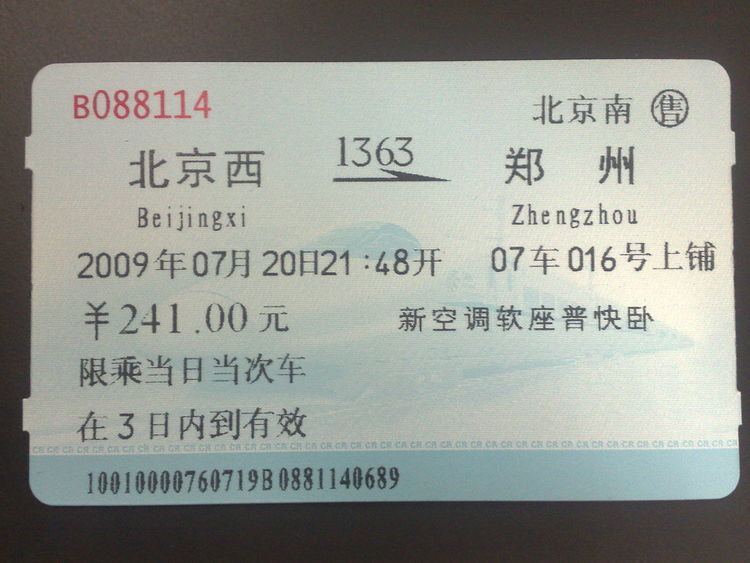 | ||
The China Railways use a single fare structure across the country. The ticket price is established by the rate-making distance (运价里程), which usually equals to the actual rail distance.
Contents
CRH trains
The CRH trains' fare was introduced on April 18, 2007.
Seat
There are three types of seats on CRH trains: deluxe, first, and second; The deluxe-class only found on CRH3C and CRH380 trains.
Some CRH trains run on conventional low-speed tracks have special discount. Some long distance train's second-class seat equals to a hard sleeper of the same distance when it is more expensive.
Sleeper
There are two types of sleepers on CRH trains: normal sleeper or deluxe sleeper; The deluxe-class only found on CRH1E trains. Each type of sleeper has upper or lower options.
The fare of a sleeper CRH train follows the formula:
Some train has special discount, for example, the sleeper train between Beijing and Shanghai provides 25% discount to the price above. For example, the train D301 from Beijing to Shanghai (rate-making distance = 1463 km), the price is calculated as:
Conventional trains
For conventional trains, the fare basis has changed several times in history. The last time it changed was on October 1, 1995, when it was changed to ¥0.05861 per kilometer. The fare vary by trains' speed, air-conditioning, and travel class (seat or sleeper).
A train ticket is composed by passenger ticket, speed-up ticket, air-conditioning ticket, sleeper ticket, insurance and others.
There are two different of passenger tickets: hard and soft. A hard-seat or hard-sleeper ticket requires a hard passenger ticket, while a soft-seat, soft-sleeper or deluxe-soft-sleeper ticket requires a soft passenger ticket.
The fare of a hard passenger ticket equals to the fare basis (¥0.05861 per kilometer). The fare of a soft passenger ticket is double. And if the distance is shorter than 20 km, 20 km is charged.
Insurance of 2% of a hard seat fare, or ¥0.0011722/km, is required for every passenger. The final price of a passenger ticket with insurance is calculated as:
There are three classes by speed:
If the distance is shorter than 100 km, 100 km is charged. The price of a speed-up ticket is rounded to ¥1.
Fare of an air-conditioning ticket equals to 25% of fare basis, or ¥0.0146525 per kilometer.
If a train has an air-conditioning system, air-conditioning ticket is required. As of 2009, almost all trains have a "new-type" air-conditioning system, that the air-conditioning system is centralized powered by locomotive or special power generation (KD) car. The price of passenger with insurance, sleeper-up, air-conditioning and sleeper tickets of a train with "new-type" air-conditioning system is 50% higher than normal trains, or 80% higher if it is a deluxe sleeper.
The price of an air-conditioning ticket is rounded to ¥1.
Any sleeper ticket is charged an extra ¥10.00 than the above formulas. If the distance is shorter than 400 km, 400 km is charged. The price of a sleeper ticket is rounded to ¥1.
Rounded to ¥1.00.
The rate-making distance is rounded up using the following rules:
For example, the rate-making distance between Beijing and Shanghai is 1463 km, the distance value 1475 km used to calculate the price.
For above prices and trip longer or equals to 201 km, the following discount rule is applied:
For ticket price less than or equal to ¥5.00, ¥1.00 is added, or ¥0.50 is added. For hard-class travels ≥ 200 km, train station air-conditioning fee ¥1.00 is charged.
For example, for the “new-type air-conditioning normal-fast” train 1363 from Beijing West to Zhengzhou (rate-making distance=689 km), so 685 km is used according to the rule above, the upper berth price is calculated as:
